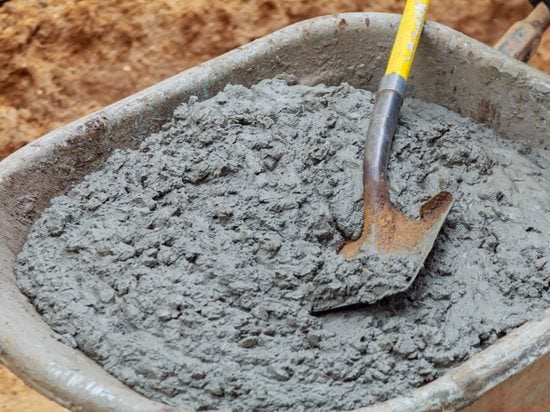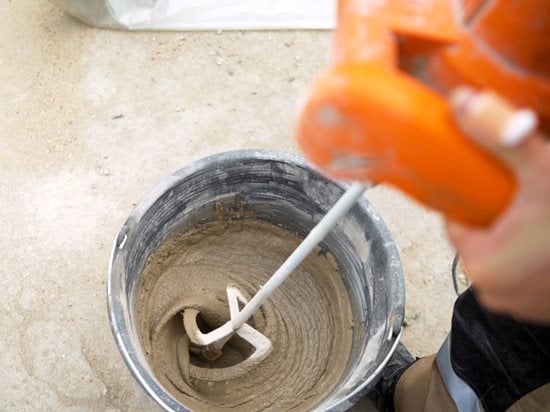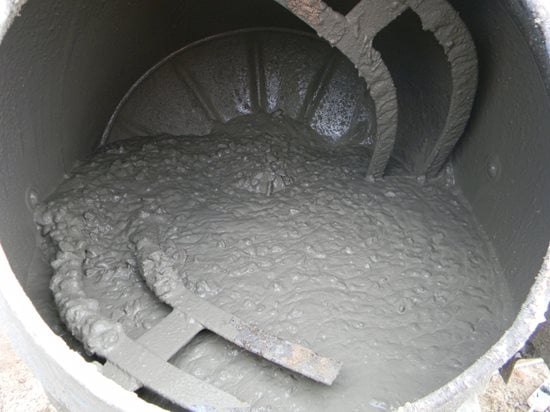- Staining Concrete
- Stamped Concrete
- Concrete Overlays
- Concrete Resurfacing
- Concrete Polishing
- Concrete Dyes
- Colored Concrete
- Indoor Concrete
- Concrete Floors
- Concrete Countertops
- Garage Floor Coatings
- Furniture, Sinks, Fire Bowls
- Basement Floors
- Outdoor Concrete
- Concrete Patios
- Concrete Driveways
- Concrete Pool Decks
- Outdoor Kitchens & Counters
- Outdoor Fireplace
- Concrete Walkways
- Concrete Pavers
- Concrete Walls
- Repair & Maintenance
- Foundation Repair
- Concrete Crack Repair
- Concrete Sealers
- Building with Concrete
- Concrete Homes
- Concrete Basements
- Decorative Concrete
- Fire Resistant
How to Mix Your Own Concrete
Learn about several methods for mixing small batches of concrete, along with safety and troubleshooting tipsThere are many creative do-it-yourself projects you can do around the home that require only a batch or two of concrete. While mixing your own concrete may seem like a daunting task, it’s easier than you might think if you have the right materials, equipment, and tools. Here’s how to get started.
Find concrete contractors near me
CHOOSE THE RIGHT CONCRETE MIX
If you have never mixed a batch of concrete before, you can avoid all the trial and error by using a preblended, bagged concrete mix. (Two common brands are Quikrete and Sakrete.) These mixes are widely available at most home-improvement stores and from online suppliers and make it easy to mix a small batch of concrete without worrying about measuring and proportioning of the components. Most products only require the addition of water. You can also find bagged mixes formulated specifically for concrete countertops.
To determine how much bagged mix to buy requires knowing the approximate dimensions of your project. Bagged mixes are typically available in quantities ranging from 40 pounds up to 80 pounds. A standard 40-pound bag will yield about 0.30 cubic feet of concrete. Here’s a calculator that can help you estimate the amount of concrete you’ll need for various projects.
As convenient as bagged mixes are, they aren’t practical for big jobs, such as a driveway or a large patio or pool deck. For these projects, it’s best to order concrete from a reputable ready-mix supplier (see Ready Mixed Concrete Ordering and Delivery).
MIXING CONCRETE IN A BUCKET
What you’ll need:
- Plastic bucket or utility tub (5-gallon capacity or larger)
- Margin trowel or a power drill equipped with a paddle mixer attachment (optional)
- Measuring pail or empty gallon milk jug (not required, but these are handy tools for measuring and dispensing water)
How to do it: Dump the required amount of bagged mix into the bucket, form a depression in the middle of the mix, and then slowly add about three-quarters of the amount of water called for per the package directions. (If you don’t need to use the entire bag, remember to adjust the amount of water accordingly.) Mix the material slowly with the trowel or paddle mixer and pour in the remainder of the water as needed. The less water you use, the stronger the concrete will be, so only add the amount necessary to obtain a workable consistency.
Best for: Smaller projects requiring 30 pounds of concrete or less, such as a concrete planter or stepping stones.
MIXING CONCRETE IN A WHEELBARROW
What you’ll need:
- Wheelbarrow
- Garden hoe or flat shovel
- Hose with spray nozzle
How to do it: Same as above, using the hoe instead of the trowel for mixing.
Best for: Projects requiring 60 to 80 pounds of concrete, such as a concrete countertop or fire bowl.
MIXING CONCRETE IN A PORTABLE MIXER
What you’ll need:
- Portable concrete drum mixer or mortar mixer (these are often available for rent in capacities ranging from 3.5 to 9 cubic feet)
- Wheelbarrow for transport of the mixed concrete to the work area
How to do it: Pour the number of bags of mix you’re using into the drum and add about three-quarters of the water recommended on the package. Then turn on the mixer and mix until the components are combined, gradually adding the remaining water as necessary until you achieve a uniform consistency. Be careful not to add too much water; use only what you need for the mix to flow freely out of the drum. Also take care not to overload the mixer. You’ll need at least 1 cubic foot of mixer capacity for each 80-pound bag of concrete mix.
Best for: Larger projects requiring multiple bags of mix, such as a small patio or sidewalk.
WHAT ABOUT DRY POUR CONCRETE?
You may have seen videos showing how to pour concrete dry. Check out our breakdown of this trend in Dry Pouring a Concrete Slab: Is It a Good Idea?
HOW TO USE A BATCH OF CONCRETE
- Make your own artisanal concrete planter.
- Pour a small concrete patio or walkway.
- Make a concrete countertop for your indoor or outdoor kitchen.
- Cast concrete stepping stones to create a garden pathway (see these pathway design ideas at LandscapingNetwork.com).
- Make a concrete bench, table or stool for your patio or porch.
- Make a concrete fire bowl or fire table.
MIXING METHODS FOR COLORED CONCRETE
Adding integral color to a plain-gray concrete mix is easy to do and will add interest to your concrete creations. Integral pigments come in powdered or liquid form and will color the entire batch of concrete, ensuring uniform color throughout. Typically liquid pigments are added to the mixing water and dry pigments are added toward the end of the mixing process, after the other materials are combined. Be sure to mix thoroughly after adding the pigment to avoid streaks and inconsistent color.
TROUBLESHOOTING
Adding too much water to a bagged mix is the most common mistake made when mixing concrete. Although water makes concrete workable, resist the temptation to add more water than you need. Many of the problems experienced with concrete are due to excessive water, including shrinkage, poor strength, and cracking (see Why Does Concrete Crack?).
It’s also important to mix the concrete thoroughly, especially if you’re mixing by hand. As a general rule of thumb, you want to obtain a uniform, moldable consistency similar to that of peanut butter or thick pancake batter. Be sure there are no dry pockets or clumps of material in your mix.
SAFETY TIPS
Whether you are mixing concrete by hand or in a drum mixer, it’s important to take some simple safety precautions to avoid skin contact and lung and eye irritation.
- Wear alkali-resistant rubber gloves and long sleeves when mixing or handling concrete. Reactions from direct skin contact with wet concrete for prolonged periods of time can range from slight irritation to more serious chemical burns.
- Wear a disposable dust mask when mixing concrete. Inhaling dust from dry concrete can irritate your throat and lungs, and frequent exposure to concrete dust can even lead to a serious lung condition called silicosis. Once the concrete is mixed with water, the mask can come off.
- Wear safety glasses, not only to protect your eyes from exposure to concrete dust but also to protect them against splatter from wet concrete. If concrete does accidentally get into your eyes, rinse them immediately and thoroughly with water.
RELATED:
Pouring Concrete
Finishing Concrete







